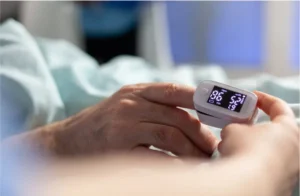
A Deep Dive into Oxygen Levels – Understanding Your Pulse Oximeter Readings
A Deep Dive into Oxygen Levels – Understanding Your Pulse Oximeter Readings A pulse oximeter might seem like just a small clip for your finger,

Remote patient monitoring (RPM) is becoming increasingly popular as a way to monitor and track patients’ health. RPM can potentially improve outcomes, reduce costs, and provide more convenient care for patients. However, there are two main options available when it comes to RPM
Bluetooth and cellular monitoring devices. It’s important to understand the differences between them in order to make an informed decision about which option is right for your needs. In this article, we’ll explore both Bluetooth and cellular monitoring devices so you can decide which one best fits your needs.
RPM devices are small, lightweight physical monitoring sensors that send data to a central server. This data can then be accessed and analyzed by healthcare professionals in order to monitor patient health. RPM devices are used for a variety of purposes such as tracking vital signs, activity levels, sleep patterns, diet and more.
RPM devices have the potential to improve patient outcomes, reduce costs associated with hospital visits and provide more convenient care for patients. RPM allows healthcare providers to remotely monitor vital signs and other data points in real-time. This can help healthcare providers diagnose and treat conditions earlier which leads to better patient outcomes. Additionally, RPM eliminates the need for frequent hospital visits, which can save time and money.
Bluetooth and cellular monitoring devices are both used for RPM, but there are some key differences between the two. Some of the most important difference that are seen in both are:
Both Cellular and Bluetooth devices have their own advantages and disadvantages.
When choosing between Bluetooth and cellular monitoring devices for RPM, it’s important to consider your specific needs and preferences. Here are some factors to consider to help you make an informed decision:
Range: Consider whether you need a device with a wider range of coverage or if a device that only needs to be in close proximity to the patient will suffice. If the patient is mobile and needs to be monitored while on the go, cellular monitoring devices may be a better choice.
Cost: Determine your budget for RPM devices and consider the cost of both Bluetooth and cellular options. Bluetooth devices are generally less expensive, while cellular devices can be more costly due to the need for a data plan.
Power: Consider whether the patient’s device is battery-powered or can be charged. Bluetooth devices require less energy to operate and may be a better option for battery-powered devices, while cellular devices require more energy.
When selecting a remote patient monitoring device, it’s important to consider all of the pros and cons of both Bluetooth and cellular devices. By taking into account factors such as cost, range, power requirements, and data transmission capabilities, you can make an informed decision about which type of device is best for your needs. Ultimately, the choice between Bluetooth and cellular devices for RPM comes down to the individual needs and preferences of the patient.
It is important to stay informed about the latest technologies available to ensure that patients are receiving optimal care. If you need help selecting an RPM device, your health care provider can provide guidance and support.

A Deep Dive into Oxygen Levels – Understanding Your Pulse Oximeter Readings A pulse oximeter might seem like just a small clip for your finger,

Lowering Hospital Readmissions with Telehealth and RPM Hospital readmissions are not only disruptive and stressful for patients but also costly for the healthcare system. According
Talk to an Expert Now